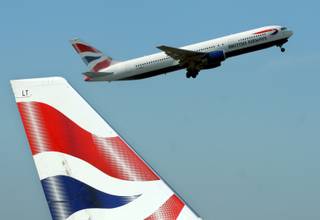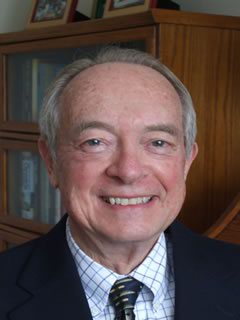Friday, May 22, 2009 | 3 a.m.
Sun Archives
Beyond the Sun
The Las Vegas tourism industry received unexpected news from abroad this week: British Airways, an airline known around the world for its high standards, global reach and sterling service, will begin nonstop daily flights to McCarran International Airport from the world’s busiest international terminal.
The London-based carrier will inaugurate nonstop air service between Heathrow International Airport and Las Vegas on Oct. 25, a plan that has been on the radar of McCarran and the Las Vegas Convention and Visitors Authority for nearly a decade.
Despite the recession and weak first-quarter earnings, British Airways decided to make Las Vegas its 19th U.S. destination and will fly a twin-engine Boeing 777 with three classes of service to Southern Nevada.
Flights will leave daily from British Airways’ sparkling new Terminal 5 at 2:20 p.m., arriving at McCarran nearly 10 1/2 hours later at 5:10 p.m. Las Vegas time. The return trip will leave McCarran at 7 p.m. and arrive the following day at 12:50 p.m.
Now comes the big question: What does it all mean?
Several Las Vegas Sun readers who commented on May 17’s initial story about the new service shared a little skepticism about the motive and prospects of success for British Airways.
Based on history, some skepticism could be well-founded.
What does British Airways see in the Entertainment Capital of the World that it didn’t see 10 years ago when the convention authority and McCarran officials began knocking on its door?
Why is British Airways doing this now when economic experts say we may not have seen the bottom of the worst recession most of us have experienced?
Is this an extremely bold business decision for British Airways that will benefit the Las Vegas economy? Or has Las Vegas just become the newest battleground in a 25-year-old feud between the airline and Virgin Atlantic CEO Richard Branson, who has enjoyed the success of a London-Las Vegas route since 2000?
Branson has been great for Las Vegas since his airline began flying here, enjoying the company of showgirls and Elvis impersonators in some of his visits. He even talked about buying or building a casino at one point. In 2007, to celebrate the beginning of Virgin America service to McCarran, he took a 400-foot bungee jump off the roof of the Palms to the delight of fans.
British Airways and Branson really don’t like each other.
The charismatic Branson has grabbed headlines worldwide with daredevil challenges to world records and publicity stunts for admirable causes. As Branson’s empire grew in the late 1980s and early 1990s, British Airways did something about it — but got caught. In 1993, Branson won a libel judgment against the airline for a “dirty tricks” campaign. British Airways was ordered to pay 500,000 pounds to Branson (more than $1 million U.S. dollars), 110,000 pounds to Virgin Atlantic and 3 million pounds (more than $6 million U.S. dollars) in legal fees. Branson split the money with his employees, calling it “the BA bonus.”
When the James Bond movie “Casino Royale” was released in 2006, Branson had a cameo role as a passenger being frisked at Miami’s airport. When British Airways showed the film on its flights, it deleted Branson and his Virgin planes.
Branson, who opposes British Airways’ proposed alliance with American Airlines, has painted “No Way BA-AA” on some of his planes. He’s also accused British Airways of monopolizing Heathrow and blocking his airline’s ability to get more flight slots at the airport 14 miles from central London. Statistics may back him up — Virgin holds only 3 percent of the takeoffs and landings at London’s preferred airport.
Today Branson is the point man in the opposition of airline alliance Oneworld’s bid for antitrust immunity on trans-Atlantic flights. Oneworld is composed of British Airways, American Airlines, Iberia, Royal Jordanian Airlines and Finnair, but Branson characterizes it as a BA-American merger.
The U.S. Transportation Department is taking testimony on the antitrust immunity filing through May.
Branson has built his own Las Vegas success by flying nonstop routes from the more remote Gatwick International Airport. On numerous occasions when I’ve talked to Branson in Las Vegas, I’ve asked about the prospects of a Heathrow-McCarran operation. He would usually smile and explain how hard it is for him to get any additional Heathrow routes.
Now, British Airways is on the verge of starting its own Las Vegas route from Heathrow where the airline has just moved into Terminal 5, one of the most beautiful airfield structures I have ever seen.
It wasn’t always that way as Terminal 5 got off to a rocky start.
A baggage system software glitch made a mess of London travel when Terminal 5 opened in March 2008. In its first five days more than 300 flights were canceled.
I passed through Terminal 5 returning from Amsterdam. My British Airways flight out of Schiphol International Airport was on time and the service was fantastic despite the full flight.
As we rolled to our gate, I got my first up-close look at an Airbus A380 superjumbo jet flown by Singapore Airlines. Someday British Airways hopes to fly some of those monstrous two-deck airliners that will create a number of headaches at U.S. airports not equipped to handle them.
Because I was transferring to a United Airlines flight, I had to board a ground shuttle to travel on the apron to one of the other Heathrow terminals, a journey that took nearly 10 minutes through tunnels at the airport. I soon discovered that not all the Terminal 5 glitches had been resolved. Even though I arrived at a secure area at the airport, I was shuttled to a location where I had to clear security a second time — and since I was flying standby, had no boarding pass or documentation, something I could get on the other side of the checkpoint.
I explained the predicament and made it home, but my experience showed me British Airways has the nicest stuff at Heathrow. The contrast between the classy, glassy Terminal 5 and the cavelike environment of Terminal 1 where United flies is like comparing the D gates at McCarran with the Jean airstrip.
So is British Airways’ new Las Vegas service just another part of the BA-Virgin battle? Is there enough passenger volume to sustain two nonstop flights between London and Las Vegas?
John Lampl, British Airways’ vice president of corporate communications in the Americas, said the new service is all about capitalizing on an opportunity with a product he thinks is superior to what his competitors offer. Terminal 5 is a technological marvel, he says, and the glitches have been worked out. Heathrow is much closer to central London than Gatwick. What’s not to love about the new service?
As for the depth of the market and the ability of the route to sustain two daily nonstops, British Airways is more networked with the rest of Europe and will capitalize on the LVCVA’s marketing of the destination throughout the continent as a means to spur traffic. In other words, British Airways is hoping that it won’t just be Britons who will be on its flights to Las Vegas.
But if there isn’t enough traffic to sustain both routes, the result could be tragic. Las Vegans can recall recent history in which Northwest Airlines carried passengers on a Boeing 747 twice a week between Tokyo and McCarran — the first Las Vegas route overseas. The service quickly evaporated when Japan Airlines began competing. When the economy skidded, Japan Airlines pulled out, and Las Vegas was left without nonstops to Asia until Korean Air began flying to and from Seoul.
It would be a shame for Las Vegas to lose a partner as loyal as Branson, who may have influenced Virgin America’s decision for rapid domestic growth in the Las Vegas market.
In the meantime, the new competitive environment could lead to some nice deals. When tickets went on sale earlier this week on British Airways’ Web site, passengers could get a round-trip with fees and taxes for $1,189.
New tourism director
The Nevada Tourism Commission’s pick for director has been appointed to the position by Gov. Jim Gibbons.
Dann Lewis, who has 40 years of experience in tourism marketing, worked for Maine. He had tourism jobs in the Bahamas and the Virgin Islands and while with the New York State Commerce Department, was one of the architects of the “I Love NY” ad campaign.
Ironically, “I Love NY” was one of the reasons he parted ways with Maine. A blogger critical of Lewis and his efforts in that state posted stories that Lewis’ wife drove a car with personalized Maine license plates “I LOVE NY.” Lewis explained that his wife, a native New Yorker, got the plates after the 9/11 terrorist attacks.
Gibbons already has been ripped for another controversial hire in Lewis, but in fairness to the governor, Lewis was the top choice of Tourism Commission. When it became clear that state lawmakers weren’t going to merge the Tourism Commission with the Economic Development Commission and that the Gibbons’ tourism budget wasn’t going to fly, the governor took the commission’s advice and hired the person it found to be best qualified.
As if Lewis won’t have enough pressure trying to find new ways to draw tourists to Nevada, you can bet that critics will be watching him closely. And his license plates.
Richard N. Velotta covers tourism for In Business Las Vegas and its sister publication, the Las Vegas Sun. He can be reached at 259-4061 or at [email protected].




Join the Discussion:
Check this out for a full explanation of our conversion to the LiveFyre commenting system and instructions on how to sign up for an account.
Full comments policy